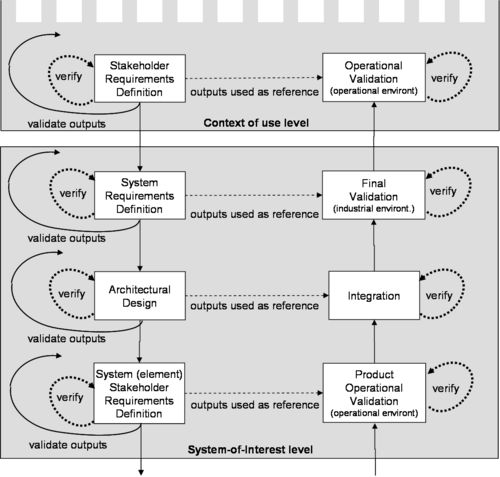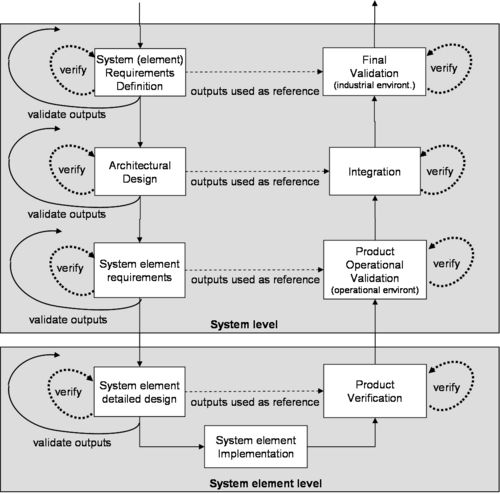Difference between revisions of "System Validation"
| Line 58: | Line 58: | ||
==Verification Actions and Validation Actions inside and transverse to levels== | ==Verification Actions and Validation Actions inside and transverse to levels== | ||
| − | Inside each level of system decomposition, Verification Actions and Validation Actions are performed during System Definition and System Realization as represented in Figure | + | Inside each level of system decomposition, Verification Actions and Validation Actions are performed during System Definition and System Realization as represented in Figure 2 for the upper levels and in Figure 6 for lower levels. Stakeholder Requirements Definition and Operational Validation make the link between two levels of the system decomposition. |
| + | |||
| + | [[File:SEBoKv05_KA-SystRealiz_V&V_Actions_upper_levels.png|thumb|500px|center|Figure 2. Verification and Validation Actions in Upper Levels of System Decomposition (Faisandier 2011) Reprinted with permission of © Alain Faisandier]] | ||
| + | |||
| + | System Elements Requirements and Products Operational Validation make the link between the two lower levels of the decomposition – see Figure 3. | ||
[[File:SEBoKv05_KA-SystRealiz_V&V_Actions_lower_levels.png|thumb|500px|center|Figure 3. Verification and Validation Actions in Lower Levels of System Decomposition (Faisandier 2011) Reprinted with permission of © Alain Faisandier]] | [[File:SEBoKv05_KA-SystRealiz_V&V_Actions_lower_levels.png|thumb|500px|center|Figure 3. Verification and Validation Actions in Lower Levels of System Decomposition (Faisandier 2011) Reprinted with permission of © Alain Faisandier]] | ||
Revision as of 03:25, 19 January 2012
Validation is a set of actions used to check compliance of any element (a system element, a system, a document, a service, a task, a System Requirement, etc.) to its purpose. These actions are planned and carried out throughout the life cycle of the system. Validation is a generic term that needs to be instantiated within the context it occurs.
Validation understood as a process is a transverse activity to every life cycle stage of the system. In particular during the development cycle of the system, the Validation Process is performed in parallel of System Definition and System Realization processes, and applies onto any activity and product resulting from this activity. The Validation Process generally occurs at the end of a set of life cycle tasks or activities, and at least at the end of every milestone of a development project.
The Validation Process is not limited to a phase at the end of development of the system. It might be performed on an iterative basis on every produced engineering element during development and might begin with validation of expressed Stakeholder Requirements. The Validation Process applied onto the system when completely integrated is often called Final Validation.
Definition and Purpose
Definition of Validation: Confirmation, through the provision of objective evidence, that the requirements for a specific intended use or application have been fulfilled.
With a note added in ISO 9000:2005: Validation is the set of activities ensuring and gaining confidence that a system is able to accomplish its intended use, goals and objectives (i.e., meet stakeholder requirements) in the intended operational environment.
The purpose of Validation, as a generic action, is to establish compliance of any activity output, compared to inputs of this activity. Validation is used to prove that the transformation of inputs produced the expected, the "right" result.
Validation is based on tangible evidences; this means based on information whose veracity can be demonstrated, based on factual results obtained by techniques or methods such as inspection, measurement, test, analysis, calculation, etc.
So, validate a system (Product, Service, or Enterprise) consists in demonstrating that it satisfies its System Requirements and eventually to Stakeholders Requirements depending of contractual practices. From a purpose and a global point of view, validate a system consists in acquiring confidence in its ability to achieve its intended mission or use under specific operational conditions.
Principles
Concept of Validation Action
Validation Action – A Validation Action is defined then performed.
Definition of a Validation Action applied to an engineering element includes:
- Identification of the element on which the Validation Action will be performed,
- Identification of the reference to define the expected result of the Validation Action.
Performance of the Validation Action includes:
- Obtaining a result from performance of the Validation Action onto the submitted element,
- Comparing obtained result with expected result,
- Deducing a degree of compliance of the element,
- Deciding about acceptability of this compliance, because sometimes the result of the comparison may require a judgment of value regarding relevance in the context of use to accept or not the obtained result.
Note: If there is uncertainty about compliance, the cause could come from ambiguity in requirements.
What to validate? – Any engineering element can be validated using a specific reference for comparison: Stakeholder Requirement, System Requirement, Function, System element, Document, etc. Examples are provided in Table 1:
Validation versus Verification
The "Verification versus Validation" section of System Verification gives fundamental differences between the two concepts and associated processes. Following table provides synthetic information to help understanding differences.
Validation, Final Validation, Operational Validation
System Validation concerns the global system seen as a whole and is based on the totality of requirements (System Requirements, Stakeholders Requirements). But it is obtained gradually throughout development stage by pursuing three non exclusive ways:
- Cumulating Verification Actions and Validation Actions results provided by application of corresponding processes to every engineering element.
- Performing final Validation Actions onto the complete integrated system in an industrial environment (as close as possible from operational environment).
- Performing operational Validation Actions onto the complete system in its operational environment (context of use).
Verification and Validation Level per Level
It is impossible to carry out only a single global Validation on a complete integrated complex system. The sources of faults/defects could be important and it would be impossible to determine the causes of non conformance raised during this global check. Generally the System-of-Interest has been decomposed during design in a set of layers of systems, thus every system, system element is verified, validated and possibly corrected before being integrated into the parent system of the higher level, as shown on Figure 2.
As necessary, systems, system elements are partially integrated in sub-sets in order to limit the number of properties to be verified within a single step. For each level, it is necessary to make sure by a set of final Validation Actions that features stated at preceding level are not damaged. Moreover, a compliant result obtained in a given environment can turn into non compliant if the environment changes. So, as long as the system is not completely integrated and/or doesn't operate in the real operational environment, no result must be regarded as definitive.
Verification Actions and Validation Actions inside and transverse to levels
Inside each level of system decomposition, Verification Actions and Validation Actions are performed during System Definition and System Realization as represented in Figure 2 for the upper levels and in Figure 6 for lower levels. Stakeholder Requirements Definition and Operational Validation make the link between two levels of the system decomposition.
System Elements Requirements and Products Operational Validation make the link between the two lower levels of the decomposition – see Figure 3.
References
Citations
Citations
Primary References
Primary references.
Additional References
Additional References.
Comments from 0.5 wiki
<html> <iframe src="http://bkcasewiki.org/index.php?title=Talk:System_Verification_and_Validation&printable=yes" width=825 height=200 frameborder=1 scrolling=auto> </iframe> </html>

